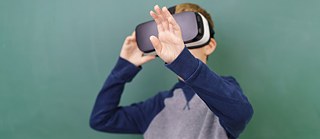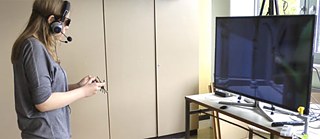Virtual reality
A subjective experience

Visual and motoric immersion plunges learners into a computer-generated environment – a virtual reality – in which they can communicate in a foreign language. Their experiences in the digital world remain highly subjective, however, which is why the virtual reality has to reflect the users’ expectations and have a proper didactical basis.
Virtual reality, a technology developed towards the end of the 1980s, is often associated with technical progress, and even with science fiction. In recent years, portable devices with immersive 3D images and motion detectors have become widespread. Adverts present them as the ultimate multimedia experience. However, a successful virtual experience depends on the users and the degree to which they are willing to embrace the virtual reality scenario.
Outside the physical reality
The goal of virtual reality is for users to be active on a sensorimotor and cognitive level in the digital environment. They leave the domain of physical reality and immerse themselves in an alternative virtual world and/or time (Fuchs et al. 2006: 7). In the oxymoron that is virtual reality, virtual does not mean not real but digital, as the programmed environment is made up entirely of digital objects.Interaction and immersion
Virtual reality is based on an exchange of information: users access the digital environment by means of a keyboard, mouse or tracking system. Depending on which VR device is used (which may include a controller, tracking system or voice recognition system), the user’s position, movements and speech are tracked and communicated to the computer. The computer then adapts the environment according to the user’s actions. The user sees the adapted environment on a screen, through 3D glasses or via a head-mounted display. Depending on the type of equipment used, the degree of motoric interaction and sensory immersion will vary.Subjective experience
This sensory and motoric immersion is designed to make users feel as if they were actually present in the scenario in question. Consequently, they engage with the situation and use the digital environment as the reference for their sensorimotor actions (Reeves in Steuer 1992: 6). How users receive and process the programmed stimuli depends on them and differs from simulation to simulation (Slater 2003).Online or offline equipment
A virtual world is an online environment that can also be experienced using a conventional desktop computer. This allows only superficial immersion in the digital environment, however. Thanks to the Internet, several users can enter the same world, influence the environment and use avatars to communicate with one another both verbally and non-verbally. Virtual worlds are very well-suited to use for school exchanges (see the project “Eine andere Welt”).Other VR settings work offline and can only be accessed by a single person. Their advantage is that the user is involved in the situation to a greater extent on a sensory and physical level.
A classroom can be used very flexibly for virtual reality learning: using just a desktop computer with Internet connection, pupils can enter virtual worlds. Some vocational schools have used the know-how of their learners to build an immersive platform themselves. Acquiring the necessary equipment is only a minor obstacle when it comes to using virtual reality in lessons, not least because head-mounted displays are becoming cheaper and cheaper. What is much more difficult is to find didactically relevant learning environments, or indeed to develop them oneself. Virtual worlds like Second Life are well-suited to such use, while tools such as Eon-Creator give anyone interested the chance to develop their own worlds.
Contextualizing the learning situation
An offline environment was developed for the European project EVEIL-3D: “Architekt 2015”, an example of a serious game, is set in Strasbourg Cathedral. The results of a study conducted within the framework of this project (Roy 2017), which involved trialling the use of virtual realities with roughly one hundred pupils from French secondary schools and one German secondary school, show that the sensorimotor immersion of the learners in the virtual environment influences the way they experience the learning situation. As they communicate with the virtual character, they produce genuine language and apply language usage strategies in the target language. Furthermore, the study was able to prove a correlation between their presence in the virtual reality and their listening comprehension in the target language (Roy 2016).
Real language use in the virtual reality
Learners may perceive tasks in the virtual environment in different ways. During the study, interviews were carried out to identify different presence profiles or types of learners. The influence of these types on foreign language use during the situation was then investigated (Roy 2017: 265).“Social learners” experience an encounter in the virtual reality: they experience a different language and an active character. Such learners interact frequently with the virtual character.
“Travelling learners” have a localized experience, interpret the characteristics of the setting and are impressed by the immersion. They tend to interact little with the virtual character.
“Active learners” get thoroughly involved, including on a physical level. For them, non-verbal interaction in the virtual environment is just as important as communication with the character.
“Stubborn learners” have problems perceiving the environment. They do not see in 3D or do not feel as if they have left the real world.
“Powerless leaners” attempt to act but fail for different reasons.
The last two types avoid interacting with the virtual character entirely. They use the shortcomings of the digital environment or the artificial nature of the communication with the virtual character to advance in the simulation.
It is with the social learners that there is clearest evidence that language use in the target language is promoted through the contextualized use of virtual reality. However, it is very difficult to predict how the virtual reality will influence learners and their language use in the learning situation because language use, interactivity and body use all influence one another.
Importance of the teacher
The immersion and interaction in the virtual reality of learners who cannot cope on their own in the virtual environment need to be properly supervised by the teacher.At the same time, however, it is important for the teacher not to intervene in the virtual reality. During the project, there were cases when the teacher commented on the quality of the language production or helped without having being asked to do so by the learner. In some cases the teacher took on the role of the virtual character, or even acted instead of the learner!
Teachers provide effective support when they encourage less autonomous learners to employ language usage strategies, when they compensate for shortcomings of the virtual character or when they help learners operate the equipment. Ultimately, teachers can enrich the experience of the learners in the virtual reality by providing encouragement and personal contact (Roy 2017: 339). While this does not require any multimedia competence on the part of teachers, they need to be capable of adopting more of a supervisory role.
Generally speaking, immersive devices (such as 3D glasses, a head-mounted display or a tracking system) help learners to immerse themselves in the virtual reality. They do not guarantee any subjective immersion, however. By providing a didactically relevant learning environment, virtual reality can contribute – if appropriately supervised – to contextualizing the learning situation and thereby promote language usage in the foreign language.
Literature
Fuchs, Philippe/Moreau, Guillaume/Berthoz, Alain/Vercher, Jean-Louis/Aubert, François d’ (2006) : Le traité de la réalité virtuelle. Volume 1. L’homme et l’environnement virtuel. Paris: École des Mines de Paris.
Roy, Mickaël/Schlemminger, Gérald (2014) : Immersion und Interaktion in Virtuellen Realitäten: der Faktor Präsenz zur Optimierung des geleiteten Sprachenlernens. In: Zeitschrift für Interkulturellen Fremdsprachenunterricht, 19. Jg., H. 2, S. 187-201.
Roy Mickaël (2017) : La réalité virtuelle pour l’apprentissage des langues. Une étude auprès d’adolescents apprenant le français ou l’allemand. Bern : Peter Lang.
Slater, Mel (2003): A note on presence terminology. In: Presence Connect, Volume 3, Issue 3.
Steuer, Jonathan (1992): Defining Virtual Reality. Dimensions Determining. In: Telepresence. Journal of Communication, Volume 42, Issue 4, p. 73–93.